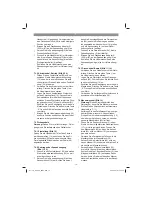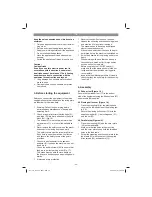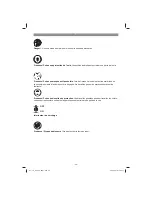
GB
- 23 -
7. Operation
Important:
The surfacing and thicknessing plane
has been specially designed for planing solid
wood. High alloy knives (21) are used for this
purpose. The contact surface of the workpiece
must be
fl
at for thicknessing. If you want to work
on large or heavy workpieces, the machine must
be secured in place (e.g. using the thread in the
machine base).
•
The ON/OFF switch (1) is on the left-hand
side of the machine. Press the green key “I” to
switch on the machine. Press the red key “O”
to switch off the machine.
•
The motor of this equipment is protected
against overload by an overload switch (35).
If the rated current is exceeded, the overload
switch will shut down the equipment. After a
short cooling down period, the equipment can
be switched on again by pressing the over-
load switch.
•
To work on long workpieces, use roller tables
or a similar supporting arrangement. Such op-
tional units are available from your local DIY
stores. They must be placed at the entry and
exit ends of the plane. Their height must be
adjusted such that the workpiece is horizontal
when it is fed into and out of the machine.
7.1 Surfacing
Warning!
Pull out the power plug before perfor-
ming any maintenance, cleaning and adjusting
work.
7.1.1 Adjustment (Fig. 1/3/5)
•
Turn the adjustment knob for cutting depth
(11) to set the height of the feed table (13).
The set cutting depth can be read off the sca-
le (18).
•
Loosen the parallel stop (6) with the clamp
lever (7). Set the required angle. The set ang-
le can be read off the scale (38). Secure the
parallel stop (6) with the clamp lever (7) again
after making the setting.
7.1.2 Fitting the chip extractor (Figure 6-8/13)
•
Fit the hand crank (4) to the post on the
planing table (14). Turn the hand crank (4)
counter-clockwise to move the thicknessing
table (20) to its lowest position.
•
Place the chip extractor (5) on the thicknes-
sing table (20).
•
Turn the crank handle (4) clockwise until the
chip extractor (5) is firmly secure and the re-
cess (b) is on the safety switch (d).
•
Attach the extraction system adapter Ø 100
mm (27) to the connection for a sawdust ext-
ractor (5).
•
Connect the plane to a chip extraction system
(not supplied).
7.1.3 Surfacing mode (Figure 9/10)
•
Undo the locking knob (32) and move the
planing knife cover (12) as far as necessary
to accommodate the width of the workpiece.
Re-tighten the locking knob (32).
•
Connect the mains plug to the mains lead.
Press the green “I” button to start the planer.
•
Place the workpiece you wish to plane on the
feed table (13). Hold the slide blocks (2) with
both hands and slide the workpiece forwards
towards the planing table (14) over the knives
(21).
•
When you have finished work, switch off the
machine. Do this by pressing the red “0” but-
ton. Then disconnect the machine from the
mains supply.
•
Return the planing knife cover (12) to its origi-
nal position.
7.2 Thicknessing
Warning!
Pull out the power plug before perfor-
ming any maintenance, cleaning and adjusting
work.
7.2.1 Adjustment (Fig. 13)
Place the hand crank (4) on the post on the
planing table (14) and turn it to adjust the thick-
nessing table (20) to the required height. The set
angle can be read o
ff
the scale (29).
7.2.2 Fitting the chip extractor
(Figure 11-15)
•
Undo the locking knob (32) and pull the pla-
ning knife cover (12) forwards as far as possi-
ble.
•
Place the chip extractor (5) on the planing
table (14). Ensure that the stop pins and the
securing screw (34) are in the appropriate
holes and are engaged in the internal threads
on the planing table (14) and that the recess
(b) is on the safety switch (e).
•
Turn the securing screw (34) until the chip
extractor (5) is secure.
•
Attach the extraction system adapter Ø 100
mm (27) to the connection for a sawdust ext-
ractor (5).
Anl_TC_SP_204_SPK7.indb 23
Anl_TC_SP_204_SPK7.indb 23
26.09.2016 11:45:16
26.09.2016 11:45:16
















































